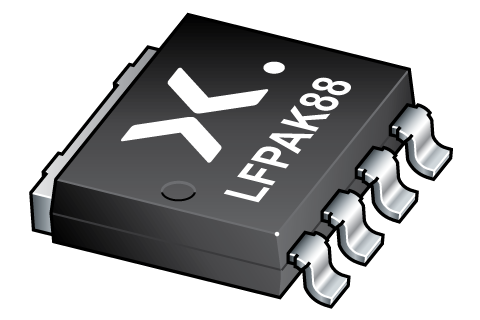可订购部件
| 型号 | 可订购的器件编号 | 订购代码(12NC) | 封装 | 从经销商处购买 |
|---|---|---|---|---|
| PSMN1R9-80SSJ | PSMN1R9-80SSJJ | 934668818118 | SOT1235 | 订单产品 |
试用我们种类齐全的评估板,体验我们的设备及其性能。深入了解我们的产品如何助您提高效率、稳健性和可靠性,让您的应用大受裨益。您可以在这里找到聚焦在应用、封装和不同的 Nexperia 产品的评估板。

Register once, drag and drop ECAD models into your CAD tool and speed up your design.
Click here for more informationN-channel 80 V, 1.9 mOhm ASFET with enhanced dynamic current sharing in LFPAK88
In high-power applications, it is common practice to connect two or more MOSFETs in parallel to provide high current capability. Even when the gates are driven from the same gate driver, it can be challenging to ensure that MOSFETs share the load current equally.
Small differences in VGS(th) for individual devices cause the MOSFET with the lowest VGS(th) to turn-on first, taking a larger share of the load current during the dynamic switching phase.
The difference in load current between individual MOSFETs (ΔID) can be significant often leading to differential heating and potential accelerated failure.
One method to reduce the ΔI between MOSFETs is to select devices with matched VGS(th), but testing & sorting MOSFETs with matched VGS(th) can be a difficult process. VGS(th) is typically measured at ΔID ≤ 1 mA and is influenced by temperature also.
ASFETs with enhanced dynamic current sharing are designed to show significantly improved current sharing with low ΔID when connected in parallel applications.
Removes the need for VGS(th) matching
Low ΔID enhances current sharing in parallel applications
Reduced VGS(th) spread
Low RDSon
286 A continuous ID Max
Avalanche rated, 100% tested
Compact and Reliable 8x8 LFPAK88 package, qualified to 175 °C
Applications using MOSFETs in parallel
Applications utilizing MOSFETs with matched VGS(th)
High-power motor control
| 型号 | Package version | Package name | Product status | Channel type | Nr of transistors | VDS [max] (V) | RDSon [max] @ VGS = 10 V (mΩ) | Tj [max] (°C) | ID [max] (A) | QGD [typ] (nC) | QG(tot) [typ] @ VGS = 10 V (nC) | Ptot [max] (W) | Qr [typ] (nC) | VGSth [typ] (V) | Automotive qualified | Ciss [typ] (pF) | Coss [typ] (pF) | Release date |
|---|---|---|---|---|---|---|---|---|---|---|---|---|---|---|---|---|---|---|
| PSMN1R9-80SSJ | SOT1235 | LFPAK88 | Development | N | 1 | 80 | 1.9 | 175 | 286 | 6 | 272 | 500 | 103 | 2.25 | N | 24807 | 2823 | 2024-10-02 |
| 型号 | 可订购的器件编号,(订购码(12NC)) | 状态 | 标示 | 封装 | 外形图 | 回流焊/波峰焊 | 包装 |
|---|---|---|---|---|---|---|---|
| PSMN1R9-80SSJ | PSMN1R9-80SSJJ (934668818118) |
Development | X1J9S80S |

LFPAK88 (SOT1235) |
SOT1235 |
REFLOW_BG-BD-1
|
SOT1235_118 |
| 文件名称 | 标题 | 类型 | 日期 |
|---|---|---|---|
| PSMN1R9-80SSJ | N-channel 80 V, 1.9 mOhm ASFET with enhanced dynamic current sharing in LFPAK88 | Data sheet | 2025-01-13 |
| AN90063 | Questions about package outline drawings | Application note | 2025-03-12 |
| SOT1235 | 3D model for products with SOT1235 package | Design support | 2020-01-22 |
| Nexperia_package_poster | Nexperia package poster | Leaflet | 2020-05-15 |
| LFPAK88_sot1235_mk | plastic, single-ended surface-mounted package (LFPAK88); 4 leads; 2 mm pitch; 8 mm x 8 mm x 1.6 mm body | Marcom graphics | 2019-04-10 |
| SOT1235 | plastic, single-ended surface-mounted package (LFPAK88); 4 leads; 2 mm pitch; 8 mm x 8 mm x 1.6 mm body | Package information | 2022-05-30 |
| SOT1235_118 | LFPAK88; Reel pack, SMD, 13"; Q1/T1 standard product orientation; Orderable part number ending ,118 or Z; Ordering code (12NC) ending 118 | Packing information | 2020-04-21 |
| REFLOW_BG-BD-1 | Reflow soldering profile | Reflow soldering | 2021-04-06 |
| PSMN1R9-80SSJ | PSMN1R9-80SSJ SPICE model | SPICE model | 2025-04-02 |
The Nexperia Longevity Program is aimed to provide our customers information from time to time about the expected time that our products can be ordered. The NLP is reviewed and updated regularly by our Executive Management Team. View our longevity program here.
| 文件名称 | 标题 | 类型 | 日期 |
|---|---|---|---|
| PSMN1R9-80SSJ | PSMN1R9-80SSJ SPICE model | SPICE model | 2025-04-02 |
| SOT1235 | 3D model for products with SOT1235 package | Design support | 2020-01-22 |
| 型号 | Orderable part number | Ordering code (12NC) | 状态 | 包装 | Packing Quantity | 在线购买 |
|---|
作为 Nexperia 的客户,您可以通过我们的销售机构订购样品。
如果您没有 Nexperia 的直接账户,我们的全球和地区分销商网络可为您提供 Nexperia 样品支持。查看官方经销商列表。
The interactive datasheets are based on the Nexperia MOSFET precision electrothermal models. With our interactive datasheets you can simply specify your own conditions interactively. Start by changing the values of the conditions. You can do this by using the sliders in the condition fields. By dragging the sliders you will see how the MOSFET will perform at the new conditions set.